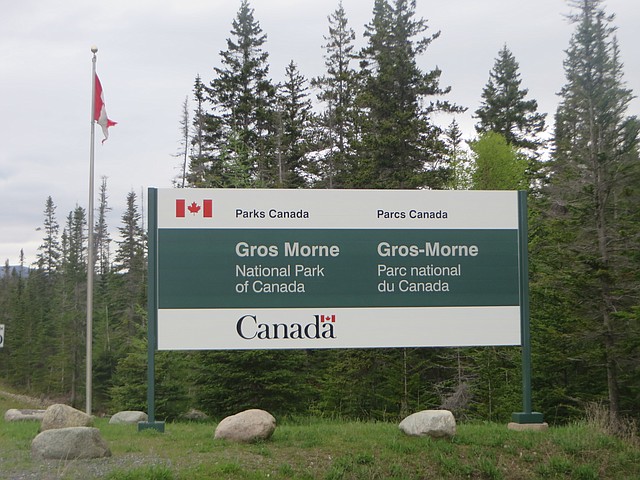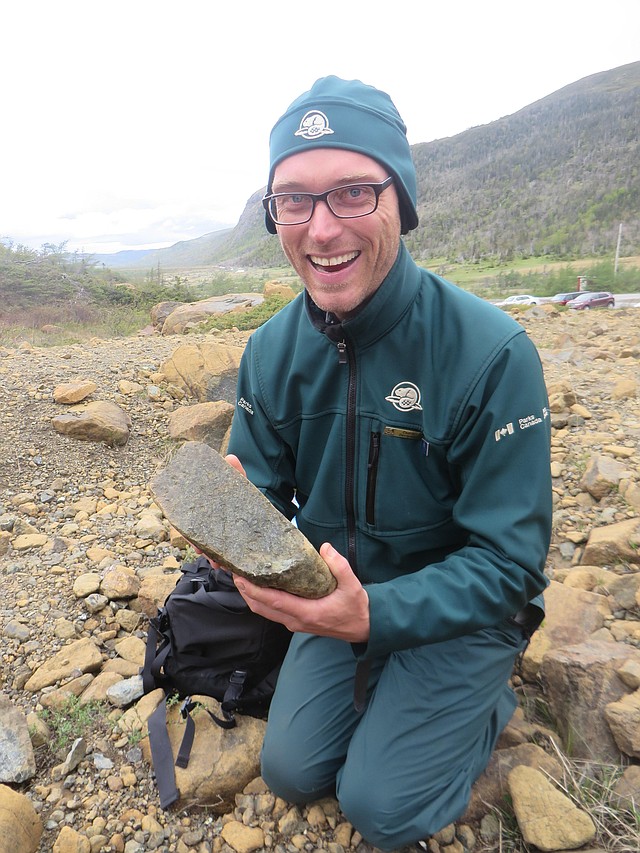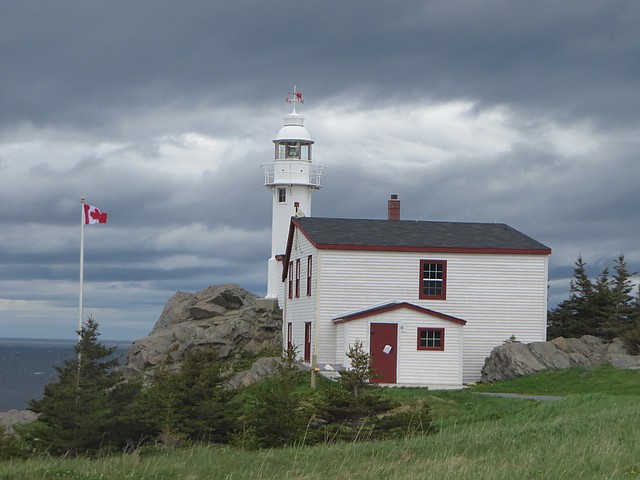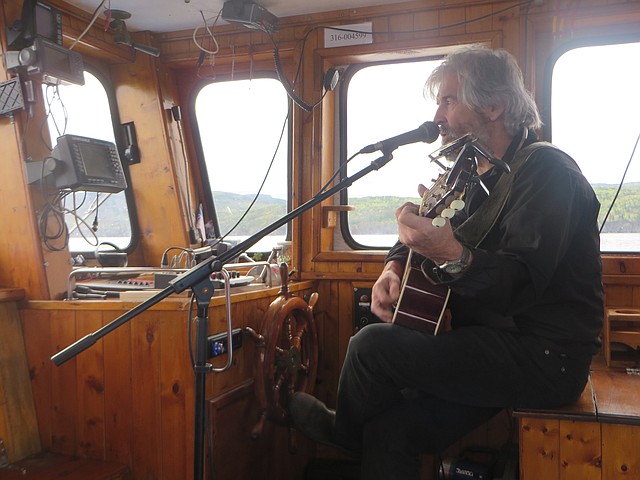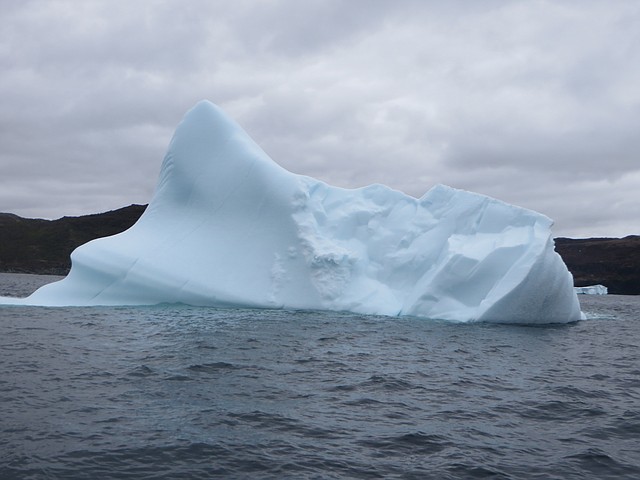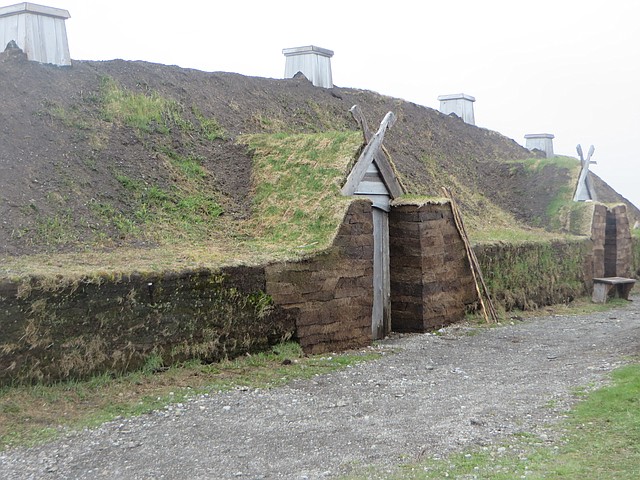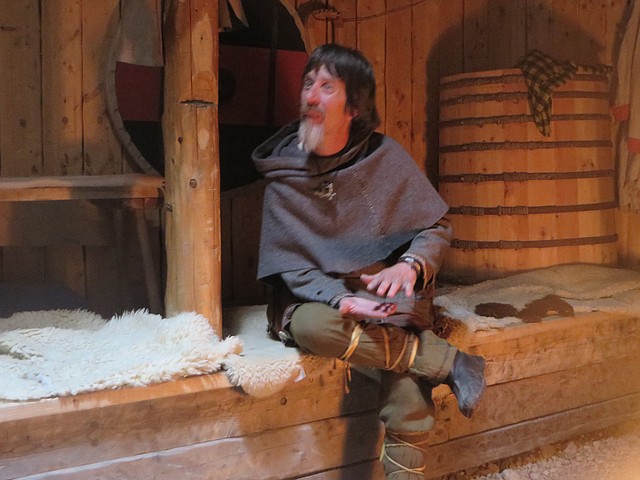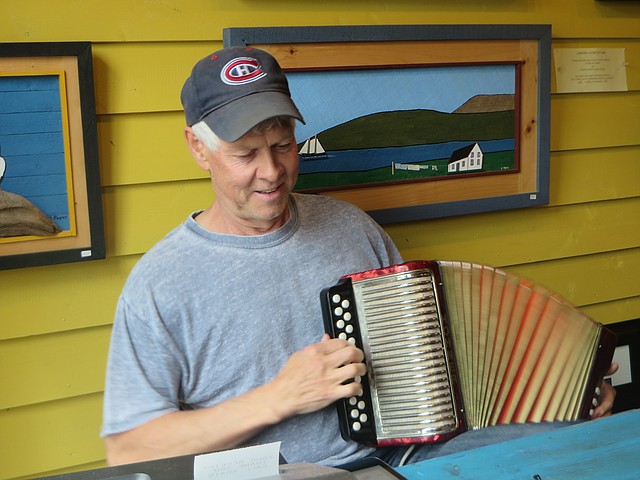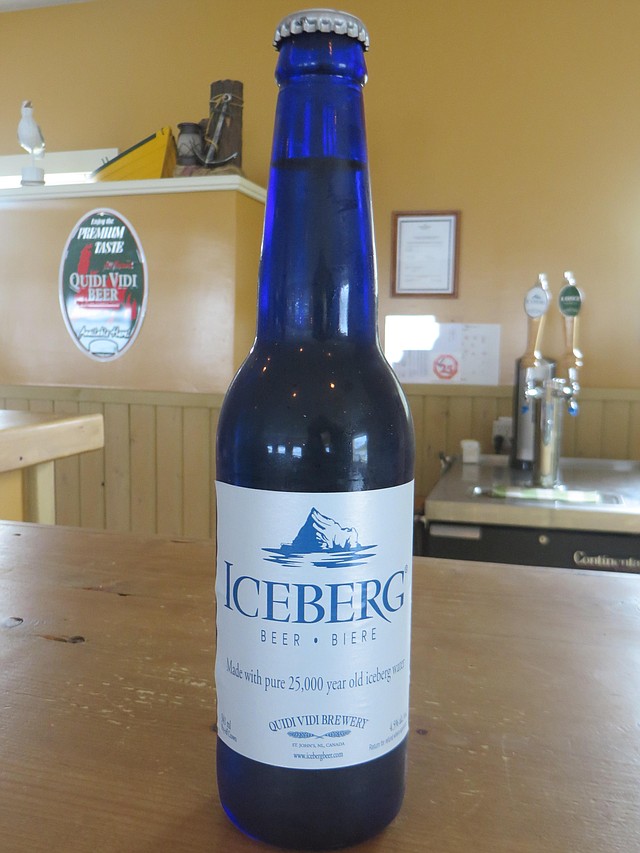Don't expect ordinary when you journey to the 'edge of the world'
June 26, 2016 at 6:00 a.m.
Kissing a codfish was never on my life’s to-do list. In fact, up until recently, I could honestly say it was not even in the realm of remote possibility. But, there I was at Skipper Hots Bar in Straitsview, Newfoundland, puckering up to smack a big one on this buggy-eyed cod. I had been talked into taking part in a “Screech In,” a ceremony that folks in this Canadian province like to conduct to make visitors feel at home. Newfoundlanders are well-known for their friendliness and hospitality and they definitely live up to this reputation, though their methods are unique!
At a “Screech In,” which is typically held at in a local watering hole, the master of ceremonies asks participants to don oversized fisherman garb, repeat various quirky Newfoundland expressions, smooch a cod, recite the Screechers’ Creed and down a shot of Screech Rum. The latter is a particular type of libation originating in Jamaica that long ago became a staple in this part of Canada. At the time, salt fish from Newfoundland was being shipped to the West Indies in exchange for rum. This resulted in fish becoming the national dish for Jamaicans and rum becoming the drink of choice for Newfoundlanders. The early fishermen tended to drink the beverage at full strength with no attempt to temper its taste. Story has it that the name “Screech” was coined when a visiting American WWII serviceman drank the rum in one toss. His howls of distress got the attention of a bystander who inquired as to the cause of this horrific screech, which prompted a Newfoundlander to reply, “The screech?” ‘Tis the rum, me son.” The name stuck and today this drink and its place in the province’s culture are legendary.
At the completion of a “Screech In,” participants are given a signed certificate acknowledging their new status as Honorary Newfoundlanders. This ritual is just one of many out-of-the-ordinary experiences visitors may have during a trip to “The Rock,” an affectionate term residents often use when referring to their home – a place that claims more rocks than soil.
Newfoundland, together with neighboring Labrador, make up Canada’s most easterly province. It’s a huge land mass that covers three times as much territory as Nova Scotia, New Brunswick and PEI. And if it were a U.S. state, it would rank fourth in regards to size, right behind Alaska, Texas and California. With a mere half a million residents, however, you’ll never encounter crowds or get into traffic jams when traveling through this vast terrain. Many regard Newfoundland as “the edge of the world,” as it is an off-the-beaten-path destination that takes some effort and time to reach. The rewards, however, are great for those who make the trek to this awe-inspiring region.
Known as an island of adventurers and adventures, Newfoundland boasts picturesque, unspoiled scenery and an incredibly diverse landscape. There’s everything from miles of rugged, windswept coastline and pristine waters with sheltered coves and inlets to dramatic mountain ranges, towering cliffs and stark moonscapes. The geology of Newfoundland stretches back to the beginnings of the earth itself. One of the best spots to see this evidence is Gros Morne National Park, a UNESCO World Heritage Site located on the western side of the province. Ranked as one of our planet’s most significant natural areas, Gros Morne contains rocks that were once part of an ancient ocean and later thrust up to form the Appalachian Mountains as two continents collided. Glaciers carved this place, creating its notable geological features and exposing the rock for scientific study, helping define and provide some of the world’s best illustrations of plate tectonic theory.
As you hike around this park, you’ll be spanning over 500 million years of Earth history. At the Tablelands, for example, you’ll witness one of the few places where Earth’s mantle is revealed. Take note of the orange weathered rock, as it is from the middle layer of our planet, and is, in many scientists’ opinion, the best and most accessible example of exposed mantle material in the world. In the words of a Canada Parks’ interpreter, “Here’s where you can see the Earth naked.”
Gros Morne is a place of raw beauty that impresses with its array of mountains, forests, lush meadows, barrens and seascapes. There’s much to explore and a good place to start is at the Discovery Center, where staff, exhibits and daily activities will help you get your bearings. The park offers twenty trails leading to panoramic overlooks, sea stacks, waterfalls, coastal bogs and other natural wonders. Within its boundaries are several fishing communities, a marine research center and even an historic lighthouse.
Built in 1897, Lobster Cove Head Lighthouse features interpretive exhibits about the communities of the National Park and how people made their living from the sea for more than 4,000 years. Original artifacts, documents and photos help to make the story come alive. A special wall pays tribute to the lighthouse keepers, while one of the rooms portrays the light keeper’s den as it might have looked in the early part of this century. Short paths through elfin forest take you to several viewpoints over the Gulf of St. Lawrence and a set of stairs winds down to the shore.
For an opportunity to observe marine flora and fauna in this part of Newfoundland, make sure to stop in at Bonne Bay Marine Station. Operated by Memorial University, this world class teaching and research facility is located on scenic Norris Point. A guided tour of the aquarium allows you to discover the unique sea life living in Gros Morne National Park. The touch tank is a highlight, but the blue lobster takes top billing in my opinion.
Another highly recommended activity at Gros Morne is the Western Brook Fjord Boat Tour. You’ll spend two hours cruising this iconic, glacier-carved, freshwater fjord lake with its stunning billion year-old cliffs and cascading waterfalls. It’s a jaw-dropping setting and a favorite of photographers.
If you’re still chomping at the bit for more boat tours, rest assured as Newfoundland has them in spades. South of Gros Morne in Humber Valley, at Cox’s Cove, check out True North, which plies the waters within the Bay of Islands. Captain Tony is a font of knowledge when it comes to all things Newfoundland. He will regale you with tales and even sing you some songs, while accompanying himself on the guitar…and steering the boat with his feet at the same time! His wife Joan joins in on the act, too, with stories of her youth and the resettlement era.
My favorite boat excursion, however, took place in the coastal waters off St. Anthony, near the northern point of the island. Northland Discovery Tours offers memorable trips through a section of Iceberg Alley, an area known for its bounty of icebergs, whales and seabirds. These frozen giants, each weighing between one and two hundred thousand tons, drift past the shores, making their way entirely at their leisure. They come in all shapes and sizes and as they never stay in one place too long, their presence creates an ever-changing landscape. Northland’s tours, which are fully narrated by an onboard naturalist, bring you within spitting distance of a number of these behemoths. We were told some of them were up to 15,000 years old and that they came from the west coast of Greenland, taking close to two years to make the journey.
You’ll discover that the bergs have names such as tabular or bergy bit, based on their size, or in the case of a growler, for the sound they make as they plunge into the sea. We passed a ginormous tabular with dimensions over fifty feet high and 500 feet long. The sheer size of it was impressive, especially when you learn that only ten percent of an iceberg is actually visible. The other ninety percent is below the surface of the water. These cathedrals of ice often serve as means of transportation for polar bears and seals and if you’re very lucky, you might spy one of these creatures hitching a ride.
You’ll also have the chance to see whales, as the coastal waters off St. Anthony are noted for its annual gathering of humpbacks. Sightings of minke, fin and killer whales are common, too. Additionally, this area has the greatest concentration of white-beaked dolphins in the North Atlantic, along with a display of bird life that includes puffins, kittiwakes and eider ducks.
A host of other wildlife makes its home in this province, and locals will be the first to tell you to mind the moose. These creatures, which are prolific in Newfoundland, can be found roaming all over the place. You’ll probably see them along the roads munching away at the vegetation. At night, however, they’re less visible until they’re right in front of you and by then, it could be too late. Use caution when driving in the evening, as that is when the majority of accidents occur.
Though many visitors are eager to spot large animals like moose and caribou, the littlest of species warrants equal consideration. I was ready to promptly dismiss the Newfoundland Insectarium & Butterfly Pavilion outside of Deer Lake, one of the province’s regional airports, but as soon as I walked in the doors, I did a 180. This award-winning destination is a showcase for some of the most fascinating creatures. Housed in a restored historical barn, the Insectarium features live and mounted exhibits of butterflies, beetles and insects from around the world, with special emphasis on those from Newfoundland and Labrador. I was particularly impressed with the observation bee hive, the amazing leaf cutter ants, stick insects and hissing cockroach. And the butterfly area is a tropical paradise where you can sit by the waterfall and watch hundreds of butterflies glide over the pond or feed from the flowers. If you’re very still, they will come and land on you. The iridescent Blue Morpho is the undisputed star.
When it comes to history, Newfoundland is in a class of its own, as it is the oldest of Canada’s provinces. At L’Anse aux Meadows, another UNESCO World Heritage Site, you’ll come face to face with the only authenticated Viking site in North America. Half a millennium before Columbus, the Vikings established a base in Western Newfoundland, a wilderness they called Vinland. The remains of their camp, which was only discovered in 1960, is the oldest known European settlement of the New World
During your visit to L’Anse aux Meadows, you’ll be able to trace the Norse journey that Leif Eriksson and his crew made, immerse yourself in Old Norse literature as you listen to the translated Vinland sagas, picture what the site looked like 1000 years ago by viewing a scale model, see authentic artifacts that proved Vinland’s origin and stand on the actual site. The remains of three halls and five smaller buildings where the Vikings lived and worked have been carefully preserved as they were when they were later discovered by Norwegian explorer and writer Helge Ingstad.
At the reconstructed sod huts, you’ll be greeted by Viking re-enactors like merchant-adventurer Bjorn, his wife Thora, the blacksmith Ragnar or other members of the crew. They’ll tell tales of trade and Norse society, and bend your ear on the best way to turn bog iron into nail. You can even get into character yourself by dressing up as a Viking and taking a picture to show the folks back home.
To gain further understanding of Norse life, drive over to nearby Norstead Viking Village, a replicated Viking port of trade, circa 790-1066 A.D. There, you can step aboard the full-scale replica of the Viking ship, “Snorri,” which sailed from Greenland to L’Anse aux Meadows in 1998 with a crew of only nine men. In the Chieftain’s Hall, hear some eerie Viking tales, sample homemade fry bread and take a turn at shaping clay into pottery the way the Vikings did. Or try your hand at spinning sheep fleece into yarn using ancient drop spindle technology. With the assistance of costumed interpreters, the site conveys the look and feel of the Viking era.
While you’re in St. Anthony’s, you’ll hear of an Englishman named Sir Wilfred Grenfell. He’s famous in these parts for the work he did to improve the life of the people in Newfoundland and Labrador. Grenfell practiced medicine, built hospitals, established schools and orphanages and traveled around drumming up financial support, while encouraging others to help him in his mission. For his many years of selfish devotion and service, he was knighted by King George V.
Visit the Grenfell Interpretation Center for a fascinating look at Grenfell’s life and times. The medical equipment used in those days will make you shudder and appreciate the modern advances made in this field. Nearby is the Grenfell House Museum, the home of Dr. Grenfell, his wife Anne and their three children. Overlooking the harbor, the building was regarded as the “castle.”
Newfoundland is dotted with charming towns and equally charming inhabitants. The people are open and warm, as well as famous for their sense of humor. They enjoy talking to visitors and will often pepper you with questions as to where you’re from and what you think of their home. Conversations with the locals can be quite amusing, as “Newfoundland English” is peculiar and sometimes downright incomprehensible. Initially, you may think it’s a foreign language and will want to rush into the first bookstore you see to get a dictionary to help you make sense of what’s being said. There are actually over 360 dialects that carry the thick remnants of Irish and English accents and expressions. A favorite that tourists will often hear is “come from aways,” as that indicates you’re not from Newfoundland. Another oddity is the use of the plural form of the verb when speaking in the first personal singular, such as “I wants a drink.” I particularly like the expressions “I’m just swarving around,” meaning one is wandering aimlessly and “I dies at you,” which is short for “I’m dying of laughter at you.” And then there’s “tuckamore,” the name Newfoundlanders have given to the stunted trees you’ll see near the coast. Due to the harsh growing conditions, these shrubs start bending and contorting themselves into bizarre sculptural shapes as a way to adapt to their environment.
If you think the language is unusual, try keeping track of time here. Newfoundland has its own time zone due to its unique geographic location. Newfoundland Standard Time is a half hour ahead of Atlantic Standard Time. However, if you visit Labrador, you’ll be back on Atlantic Standard Time. Confusing, to say the least!
The province has a colorful and romantic cultural heritage, which is especially evident in its arts scene. Music is part of both the natural and cultural landscape and you can find it practically everywhere you visit. Drop into a pub or go to a festival or event to sample live traditional music that speaks of the pride and deep attachment Newfoundlanders have for their home. Celebrations abound heralding everything from the icebergs and whales to lobsters and the arrival of spring in a region where winter can be long and cold. But these hearty salts of the earth are rarely bothered by their weather. They accept and embrace it, as it has been a continuous part of the fabric of their lives.
One of the area’s signature musical experiences is the Anchor’s Aweigh Show at Anchor Pub in the Ocean View Hotel, which is located in Rocky Harbor. This musical group has been entertaining tourists for twenty years and its blend of humor and nostalgia gives audiences the ultimate taste of Newfoundland culture. You’ll be clapping your hands, tapping your feet and maybe even doing an Irish jig to the band’s tunes before the night is over.
Newfoundlanders are also known for their stories and creative talent. A variety of popular amateur and professional theatrical companies offer visitors a glimpse of authentic Newfoundland history. And artists abound displaying their crafts from rug hooking and ceramics to glass and iron work. There’s plenty of places to shop for folk art and traditional products, and often the proprietors are working artists themselves who are happy to demonstrate their craft.
With all this activity, you’ll need sustenance. No worries there! Newfoundlanders love to eat and with the rich waters off their coast, it’s no surprise that much of their traditional cuisine includes fish. Seafood reigns supreme, with cod the belle of the ball. You’ll find it on every menu, prepared in dozens of ways – salted, au gratin, pan fried, deep fried in the proverbial fish and chips style, hazelnut crusted, in cake-like form and more. And if you’re a shellfish aficionado, you’ve definitely come to the right place, as you can feast on the likes of fresh lobster, crab, scallops and shrimp. For the carnivores, moose is a must. Accompany your meal with a glass of Iceberg Beer, made with – you guessed it - water from icebergs. There’s no minerals in the water, just a lot of tiny bubbles, which gives this golden brew a very light taste.
Finally, top off your meal with a dessert made from local partridge berries or cloudberries, more commonly known as bakeapples in Newfoundland. You won’t be disappointed! Then again, disappointment is not a sentiment you’ll ever experience while visiting this captivating and enchanting place.
For more information about visiting Western Newfoundland: www.gowesternnewfoundland.com
Deborah Stone is a travel and lifestyle writer, who explores the globe in search of unique destinations and experiences to share with her readers. She’s an avid adventurer who welcomes new opportunities to increase awareness and enthusiasm for travel and cross-cultural connections. Her stories appear in a number of publications as well as on various travel websites. Additionally, she can be frequently be heard dishing travel with the hosts of the NPR-affiliated and AARP produced talk radio show, “2 Boomer Babes.” Deborah is a longtime Seattle area resident, who currently resides in Santa Fe, New Mexico.


